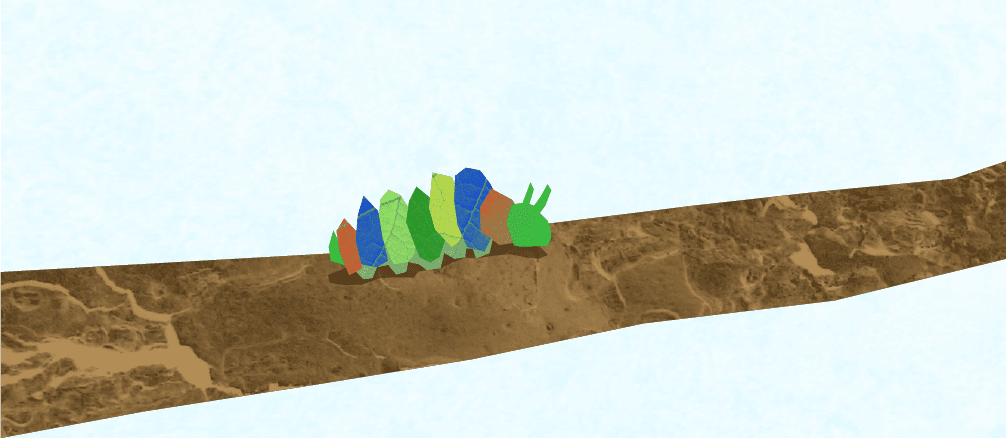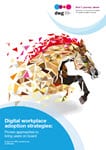From caterpillar to butterfly: How Nationwide made the case for intranet transformation

Within the space of three years, Nationwide climbed from near the bottom of Digital Workplace Group’s benchmarking tables (2013) to almost top (2016). In this new blog post series, we look at how the Nationwide team guided their organization through the transformation from caterpillar, through cocoon, to butterfly.
The Very Hungry Caterpillar is a beloved children’s book, translated into at least 40 different languages, and instantly recognizable through its beautiful illustrations of a caterpillar going through its transformation as it eats and eats, before finally spinning a cocoon around itself and later emerging as a butterfly. For children, it can often be the first time they hear of this wonderful creature and about the concept of transformation; they are introduced to the idea that one thing can radically change into another.
And so, it is The Very Hungry Caterpillar which comes to mind when the story of Nationwide is told. The team knew that a change was needed as their intranet was ticking along but not functioning as well as it should. Their journey from caterpillar through to the “cocoon” of their project, then emerging as a butterfly with a brand new, high-performance intranet, is one of hard graft and planning for the long term. We’ll be exploring each stage of this former Digital Workplace Group (DWG) member’s story in this three-part series, teasing out the lessons learned so that others too can embark on a transformation from caterpillar to butterfly.
The case for change
One of the hardest points from which to make the case for change is when there is no particular catastrophe requiring immediate firefighting, or even looming on the horizon. This was the position for Nationwide in 2013 when the intranet – at the most basic level at least – was still doing the job it needed to, despite the technology nearing its end of life and the team recognizing that drastic change was needed.
“It was perceived as being okay, but we knew from a team perspective it wasn’t in a good place,” remembers Jon Simons, Digital Channels Senior Manager. “Search wasn’t really search but a list of best bets. We had 40,000 pages, which we knew weren’t getting reviewed and were also too many for what we actually needed. But people who had been around for a long time knew how to use it, even with its poor findability.”
The technology on which Nationwide’s intranet was built was seemingly unique. “I’ve never met anyone else who was using it,” smiles Jon. And as it reached the end of its support from the vendor, the company was indeed looking to replace it. However, the intranet shared the technology with its more glamorous cousin, the external website. With a website’s customer-facing purpose, it is often relatively easy to make the case for funding in this area, which is perceived as having a larger impact than internal systems; it can be much harder to make the same case for the intranet, particularly when resources are limited.
Setting the ambition for transformation
It was against this backdrop that Nationwide rejoined DWG’s member forum in 2013. Having been members before, they already knew that the community offers deep value in drawing back the curtain on other organizations’ intranets and approaches. “We wanted the ability to see what others were doing and to learn from them,” reflects Jon, “and to get an honest view of where we were, to be able say internally ‘We need to do something’.”
CEO and Founder of DWG, Paul Miller, believes that Nationwide is in a way a model DWG member. “They have always been keen to grab any best practice. They’ve given very generously, while also astutely acquiring knowledge from fellow members and DWG experts; they made their presence felt. You can be skilfully ambitious and grab onto learning opportunities, while at the same time being generous in what you share back.”
Both Jon and Paul independently point to a DWG member meeting at Barclays as a memorable moment in the Nationwide team’s journey, when they were able to see the art of the possible. Jon recalls hearing what Barclays had achieved with its mobile programme and thinking: “That certainly set a vision.” Likewise, Paul has a vivid memory of observing Nationwide and Barclays deep in conversation with one another towards the end of the day.
Jon and his team were also driven by the changes and technological advances they saw happening around them within the wider world. “We weren’t oblivious to the world that was changing around us outside of work, and wanted to consider whether we could bring these new ways of accessing and sharing information and having conversations into our workplace.”
Luckily, around that time, Charlotte Kensett was appointed to head up the team responsible for the intranet and she was also keen to fight for the change needed to improve the platform. Charlotte was key in helping the team progress, and they succeeded in securing money for an upgrade.
The project quickly became known as “the upgrade project, but language is important. The team knew this wasn’t actually their ultimate goal and so set their sights on “transformation” instead. “We didn’t want to just upgrade the technology and end up back where we started.” The team wanted to put a strong focus on making sure they could make their content as good as it could be, as well as improve the information architecture, overall navigational structure and search. They also wanted a new team structure and governance in place, to make sure the platform could be managed effectively and sustainably.

Stalling and benchmarking to start again
The project kicked off, but the team soon found they’d bitten off more than they could chew. Ten months in, it became clear that it just wasn’t feasible to achieve everything they wanted to in one go. Not only was it too much to try for a full transformation in a single project, but the team also found that senior leadership wasn’t fully on board.
It was at this point, with the project stalled, that Nationwide undertook DWG’s full roster of intranet benchmarks, covering Strategy & Governance, Communication & Collaboration, Metrics & Performance, and Usability.
The findings weren’t pretty. When compared to fellow members who had also been benchmarked, Nationwide was close to the bottom of the league table in all four areas. However, far from being a shock, this was just the kick the team needed to reinvigorate the project. “We knew we were bad, but it was helpful to have that objective confirmation,” says Jon. The findings from the benchmarks helped them refocus their energies on a number of high-priority areas and gave them the evidence they needed to go back to senior leadership and truly make the case for change.
“We realized we hadn’t explained it well enough to senior leaders – what we were doing, what their role was. We also realized we’d possibly not been speaking to the right people.”
The team first went through the project steering group, securing funding to focus specifically on content and usability. With the benchmarking findings in hand, together with targeted research and management information (MI) into each business area’s content, the team then held a series of familiarization sessions for senior leaders. They covered the state of the current intranet, using the benchmarking data to back their presentations up, while also personalizing the challenge by calling out the problems in each leader’s own content area and suggesting how they could help. In a decentralized publishing model, this latter message was critical in getting the leaders on board. Risk was also a strong calling card, with DWG having pinpointed Nationwide’s lack of governance as a particular concern for a financial institution.
Case made
The meetings were a success and the team were pleasantly surprised not to receive any of the pushbacks they would normally expect. “Without the benchmarking, we’d have been asked: ‘Why the intranet and not any of our other systems?’ and ‘Are we really that bad compared with other organizations?’. The benchmarking findings clearly provided the answers to these questions in black and white.”
As a result, the team were able not only to reinvigorate their transformation programme but also to secure an EXCO member as their executive sponsor.
DWG’s Director of Client Services Ed Taylor sees this as critical. “Nationwide recognized the need to change their intranet and approach to digital for their staff. Prior to their intranet project, all the major banks were doing a lot of work to improve their customer experience, investing in mobile apps, mobile-responsive sites, a cleaner user experience that was easy to navigate, and so on. Nationwide acknowledged that to be a leader in customer service, they also had to improve internally. Getting the intranet project backed by the COO and having a Group Director as the sponsor ensured there was serious investment in the programme and that it was well resourced.”
Just three years later, following another series of benchmarks, Nationwide had zoomed to near the top of DWG’s benchmarking table, something that Nancy Goebel, DWG’s Managing Director of Membership and Strategic Partnerships, points to as her favourite memory of Nationwide’s time with DWG. In the remainder of this series, we’ll be looking at how they achieved this through both a successful project and an effective long-term programme.
Lessons learned for making the case for change:
- Learn the art of the possible from others who have gone before you, to help build your own vision.
- Obtain benchmarks that illustrate with data how you are performing compared to other organizations, what the key risks are for you, and that can be used to provide evidence for your progress.
- Think big: Is there an opportunity to “transform” rather than simply “upgrade”?
- Be focused in prioritizing the key areas for immediate change but also in creating a roadmap to ensure that less urgent but nevertheless important areas get addressed further down the line.
- Ensure that you’re speaking with the right senior leaders and personalize your messaging so that they can see what the change will mean for them.
In our next post, we’ll be diving into the detail of how the Nationwide team ran their transformation project, focusing on elements that often get forgotten or deprioritized as the hectic business of development takes over. What exactly was going on inside that cocoon?
RESEARCH AND RESOURCES
● FREE CHECKLIST: Setting up a Digital Workplace
● FREE REPORT: Digital Workplace 2030: Preparing now for the digital worlds of work to come
TAKE THE NEXT STEP
Digital workplace adoption strategies: Proven approaches to bring users on board
Categorised in: Intranets

